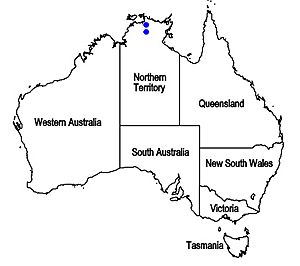Pityrodia byrnesii facts for kids
Quick facts for kids Pityrodia byrnesii |
|
|---|---|
| Scientific classification | |
| Genus: |
Pityrodia
|
| Species: |
byrnesii
|
 |
|
| Where this plant grows in Australia | |
Pityrodia byrnesii is a flowering plant that belongs to the mint family, called Lamiaceae. This plant is only found in Arnhem Land in the Northern Territory of Australia. It is a type of shrub with hairy stems that have tiny glands. Its leaves are flat and don't have stalks. The flowers are off-white and bell-shaped. They have a sweet smell and purple stripes inside.
About the Plant
Pityrodia byrnesii is a shrub that can grow up to about 1 m (3 ft) tall. Its branches are covered with many tiny glands and hairs, making them sticky.
The leaves grow in groups of three along the branches. Each leaf is about 1.5–3 cm (0.6–1 in) long and 4–10 mm (0.2–0.4 in) wide. They feel sticky because of the glands. The top of the leaves is smooth, and the underside has a clear line down the middle.
The Flowers
The flowers of Pityrodia byrnesii smell sweet. They grow one by one on a sticky, hairy stalk that is very short, less than 2 mm (0.08 in) long. Special leaf-like parts called bracts surround the flowers. These bracts are long and narrow, like a spear tip.
The outer parts of the flower, called sepals, are 8–12 mm (0.3–0.5 in) long. They join together to form a bell-shaped tube with five pointed tips. The tips are hairy and sticky on the outside, and hairy on the inside. The tube itself is sticky and hairy outside, but smooth inside.
The five petals of the flower are joined to form a tube that is almost like a cylinder, about 11–13 mm (0.4–0.5 in) long. This tube is off-white. It has dark purple stripes on its top part. The tips of the petals form two "lips." The top lip has two tips, and the bottom lip is longer with three tips. The middle tip on the bottom lip is the biggest.
Inside the flower, there are four parts that hold pollen, called stamens. These stamens stick out a little from the end of the tube. Two of them are a bit shorter than the other two. This plant flowers almost all year round. After flowering, it grows an oval, hairy, sticky fruit.
How it Got its Name
Pityrodia byrnesii was first officially described in 1979. A scientist named Ahmad Abid Munir wrote about it. He found a sample of the plant near the East Alligator River in the Northern Territory.
The plant's special name, "byrnesii," was given to honor Norman Byrnes. He was an Australian scientist who studied plants.
Where it Lives
This plant, Pityrodia byrnesii, grows in Arnhem Land. You can find it near the East Alligator River. This area is about 10 km (6 mi) south-west of Oenpelli, which is inside Kakadu National Park.
Looking After the Plant
Pityrodia byrnesii is currently listed as "data deficient." This means there isn't enough information yet to know if it's in danger or not. This classification is under the Territory Parks and Wildlife Conservation Act 2000. More studies are needed to understand its population and how to protect it.

